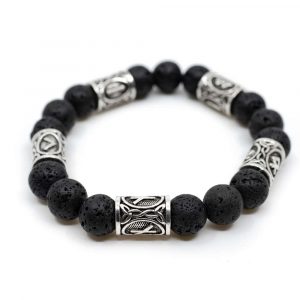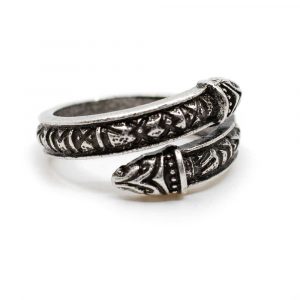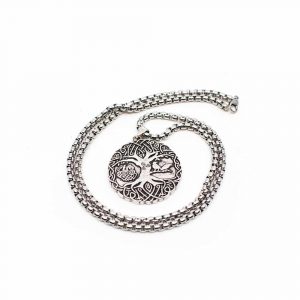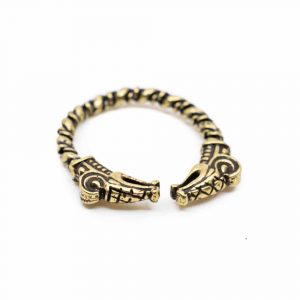























You could buy viking jewelry because of the symbolism, or just because you think it’s pretty! The impressive Vikings were Norse people, and their myths, traditions and symbols are still valued today. Viking jewelry often has a remarkable design, decorated with symbols shaped like animals, gods and important Norse signs. Generally speaking, they are very cool and eccentric showpieces!
There is plenty to choose from when it comes to Viking jewelry; for example, there are Viking bracelets, Viking pendants, Celtic rings and even hair accessories with Norse symbols on them. Before you buy anything, it might be nice to know the meaning of all those symbols, because that enables you to choose the one that you like best 🙂
Vikings were tough and powerful seafaring Norsemen and women, known for their plunderings and discoveries. They lived in Scandinavia from c. 800 AD until c. 300 years after; this period is called the Viking Age. Their habits, traditions, polytheism, symbolism and especially their myths are still known today and serve as an inspiration for, amongst other things, jewelry for him and for her! 🙂
There are several Viking gods; there is, for example, a war god and a goddess of the earth. Additionally, Viking heaven is called ‘Walhalla’. In walhalla, the Vikings feast and fight alongside the gods. Below you will find the names and descriptions of a number of important Norse gods.
Odin is called the Alfather; he is the most important and powerful god in Norse mythology. He is the god of war, and because of his desire for knowledge and wisdom, Odin is considered to be the most gifted god. According to myth, many other gods owe their life to Odin. His spear, horns and his two ravens are recurring attributes associated with Odin.
Thor is the son of Odin and Fyorgyn (goddess of the earth). He is the god of thunder and destroyer of evil. Amongst the Vikings, Thor was honoured the most, even more than Odin, because of his strength, courage, constancy and sincerity. A very well-known attribute associated with Thor is his hammer.
Goddess of love, lust and beauty in Norse mythology. While she was worshipped because of her beauty, she was also considered to be fierce. According to myth, this goddess would occasionally meddle in wars, especially the Valkyries (female warriors).
Freyr is Freya’s brother and the god of fertility and spring. His father is the sea god Njord. There are several attributes associated with Freyr: his gold wild boar, his foldable gold ship and his self-fighting sword. It’s safe to assume that Freyr was a fan of anything gold!
Animals are of great importance in Norse mythology. They are comparable to totem animals of Native Americans. According to myth, many Viking gods have an animal by their side for advice and action. However, some Norse creatures are feared even by the bravest Viking. Vikings would also wear symbols shaped like an animal because of their meaning, or because they wanted to honour a particular god. Some of the most well-known mythical animals/creatures are:
Ravens were considered to be the family members/messengers of Odin, which is why they were probably one of the most important animal symbols amongst the Vikings. Additionally, Odin always has his own two ravens by his side: Huginn (thoughts) and Muninn (memories). The raven symbolised Odin’s position as the most important and powerful god, but these days it also symbolises the Vikings themselves.
Meaning of the raven: insight, wisdom, intellect, courage, battle and victory and the blossoming between life and life after death.
In norse mythology, the dragon, or other snake-like creatures, is a recurring symbol. Many stories about the gods describe snake-like creatures. For example, the dragon appears on Viking ships, where there is often a carved dragon’s head placed on the bow.
Meaning of the dragon and snakes: immense strength, but also grave danger, the creation of opportunities and taking risks. Dragons do not necessarily represent evil, but can be the symbol for the unreliable and dark side of humanity. On the other hand, this animal also symbolises change and renewal.
Fenrir is the name of one of the most terrifying mythical creatures in Norse mythology. Fenrir is a wolf, but not a regular wolf; he is gigantic and very evil. The story goes that Fenrir will escape from hell one day and will devour the sun and the moon, and thus also Odin. The wolf in general can have several meanings and does certainly not automatically symbolise evil.
Meaning of the wolf: the power of time and nature, courage, teamwork and shamanic powers. The wolf can bring out the best, but also the worst in people.
Freya, the goddess of love, had a wild boar on her side. According to myth, this boar, named Hildisvini (“Battle Swine”), would aid her during war. Boars are shy animals that prefer to avoid humans, but when they are cornered, the wild and incredible beast comes out.
Meaning of the boar: bravery, curiosity, cruelty, but also harmony and peace.
Looking at Viking jewelry, you will see many typical symbols like the hammer, runes and the tree of life. These symbols are often based on Norse mythology, on stories about the gods. For the Vikings, these myths and the corresponding signs were an attempt to better understand the world. Therefore, you will find a list of several Viking symbols and their meaning below:
Although the pentagram does not originate in Norse mythology, it is a recurring symbol. It was (and is) often used in occult or heathen beliefs. Therefore, the Vikings might have been familiar with this symbol.
Simply put, runes are centuries-old letters that together form the rune alphabet. Runes were not often used for communication, but more to predict the future with (comparable to Tarot Cards or a crystal ball). According to the stories, runes were associated with the god Odin, because he was the one who discovered the alphabet at the base of the tree of life. The letters were depicted on jewelry, beads, talismans, amulets and shields.
The meaning of runes: especially protection, victory and it is a sign to honour Odin with.
Triskele is the name that was given to the horns of Odin. The symbol is a depiction of three interlocking drinking horns. The origins of this symbol is not clear, but there are suspicions. There is the possibility of it being a sign of inspiration for early writers, poets and artists, because, as already mentioned, Odin is also the creator of the rune alphabet.
A symbol that occurs often is Thor’s hammer, also called Mjölnir. Thor uses Mjölnir to create thunder and lightning by hitting the clouds. According to myth, Mjölnir has several extraordinary powers: it can break mountains, resurrect Thor’s goats and bring blessings during special occasions, such as a wedding or a birth.
Meaning of the hammer: strength, power, courage, luck and protection.
Tree of Life (Yggdrasil)
Yggdrasil is a very important symbol for the Vikings, because this tree of life was believed to form a path between this world and the nine worlds inhabited by the gods. It was believed that these worlds were woven into the roots of the tree. The tree of life symbolised for the Vikings the reality of life.
Meaning of Yggdrasil: Symbolises the cosmos, relationship between time and fate, harmony, the cycle of creation and the essence of nature.
This symbol with interlocking triangles is called Valknut, but is also known as Odin’s knot. The triangle-shaped knot symbolises the warriors that have died in battle and who were believed to go to Walhalla (the greatest reward for a Viking). Additionally, the nine points of the triangles would possibly represent the nine worlds of the gods.
Meaning of Valknut: courage, bravery and fate in this life and the next.
This is a different kind of knot than the Valknut. The Celtic knot consists of three rounded triangles that form some kind of infinite connection. The knot is also called Triquetra, which means ‘no beginning and no end’.
Meaning of the Triquetra: a reminder of the continuity and versatility of nature and higher truths.
Vikings were very knowledgeable when it came to staying on course at sea; the position of the sun, the position of the stars, birds’ flying patterns and the colour of the water all helped them determine their location. The Viking compass, or the ‘vegvisir’ (that which guides the way), was of great importance when the Vikings went out to sea. The symbol was some kind of visible spell to not lose your way.
Meaning of vegvisir: staying on course on your spiritual journey and overcoming setbacks and changes in life.
On our website there is plenty of other symbolic jewelry to discover! There is something for everyone, including jewelry for men and children. Spiru offers a wide range of spiritual accessoires for every person. For example, we sell flower of life pendants, shamballa bracelets, bohemian earrings and rudraksha malas. Each item has its own symbolic background. Did you know that every gemstone type has its own meaning? Choose the healing crystals that fit you best and choose one of our beads bracelets, rough pendants or gemstone earrings. All your favourite symbols are included in Spiru’s jewelry!
© 2024 Spiru